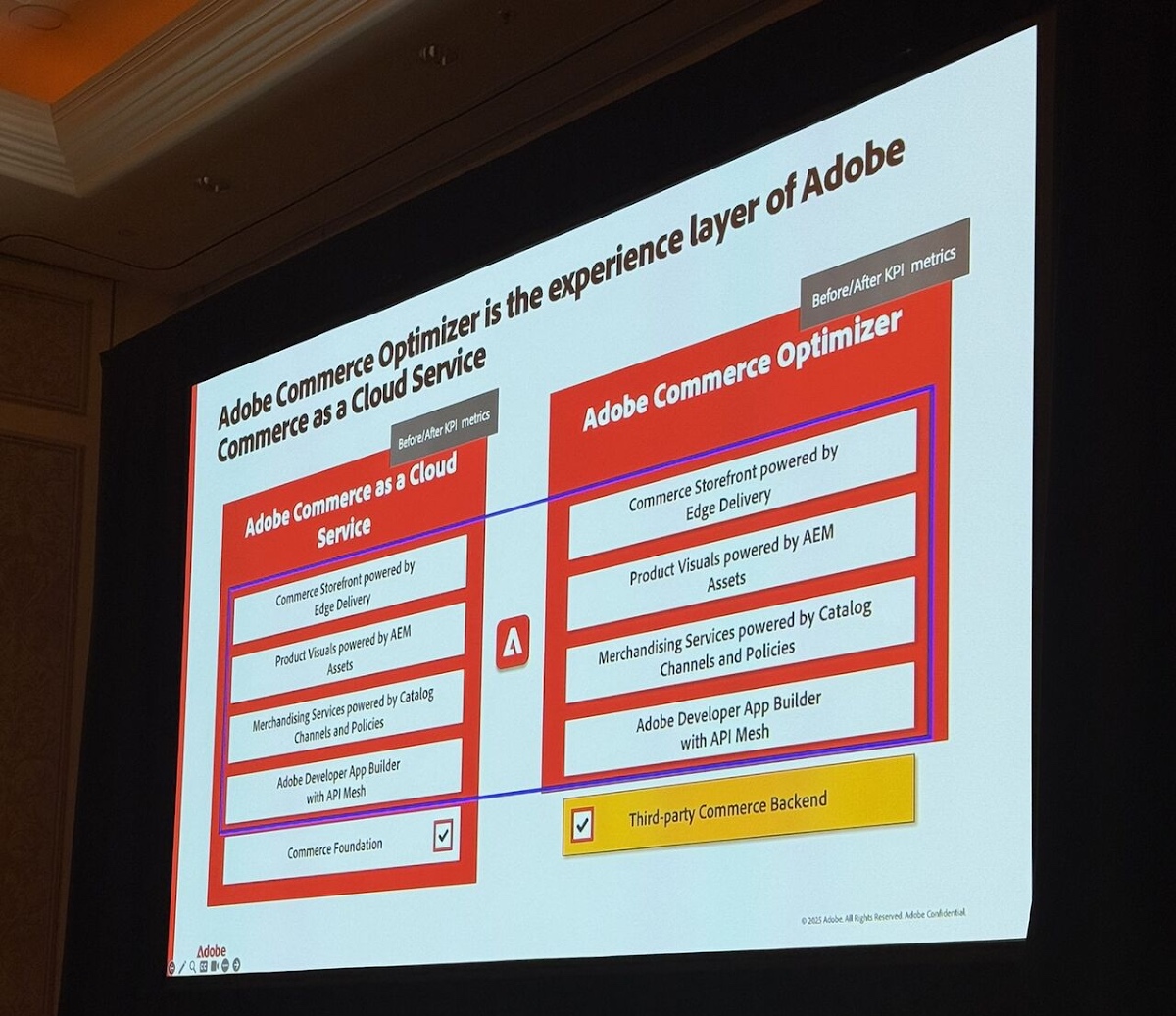The new era of digital commerce
The e-commerce market reached a significant milestone in 2024: according to Adobe Digital Insights, the total online retail volume exceeded the 1.05 trillion dollar mark for the first time. At the same time, mobile sales exceeded desktop sales for the first time at more than 500 billion dollars. These record figures illustrate the immense importance of a powerful e-commerce platform for business success.
But while online commerce is thriving, retailers face enormous challenges: reducing operational costs, differentiating themselves from third-party marketplaces and meeting complex B2B requirements. Adobe has recognized these challenges and presented two groundbreaking solutions at the Adobe Summit 2025: Adobe Commerce as a Cloud Service and Adobe Commerce Optimizer.
In this blog post, we look at how these innovations are changing the e-commerce landscape and the tangible benefits they offer for B2C and D2C merchants. We take a detailed look at the technologies, present practical examples and provide recommendations for your e-commerce strategy.

What is Adobe Commerce as a Cloud Service?
Adobe Commerce as a Cloud Service represents a paradigm shift in the e-commerce world. It is a fully SaaS-based version of Adobe Commerce (formerly Magento) managed by Adobe and will be generally available from June 2025.
The most important features at a glance:
- 100% SaaS solution: Fully managed by Adobe
- Versionless: Constantly updated without manual upgrades
- Fast onboarding: Provisioning in less than 2 minutes
- Scalability: Automatically adapts to peak loads without sacrificing performance
- Edge-based commerce storefront : Extremely fast loading times thanks to edge delivery
- Integrated digital asset management: With Adobe Express and Firefly
- AI-powered personalization: Through integration with Adobe Experience Platform
Unlike conventional e-commerce platforms, resources no longer need to be spent on upgrades, patches or security updates. This leads to significant cost savings and allows you to focus on your core business: Winning customers and increasing sales.
Architecture and technical foundations
The technical basis of Adobe Commerce as a Cloud Service is based on a cell-based architecture that enables horizontal and vertical scaling. This architecture, which is also used by other Adobe Experience Cloud products, offers dynamic scaling and runs on a modern Kubernetes platform.
A special feature is the "super graph" approach: developers have access to all APIs via App Builderallowing them to start development quickly. The entire infrastructure is based on proven AWS services and other managed services, which together form the powerful cloud service platform.
The commerce storefront based on edge delivery
At the heart of Adobe Commerce as a Cloud Service is the edge-based storefront. Delivered via a global content delivery network, content is loaded at lightning speed, resulting in excellent Google Lighthouse scores. In a live demonstration at the Summit, a comparison was made between a self-developed e-commerce platform and Adobe Commerce as a Cloud Service:
- Self-developed platform: Lighthouse score of 38 (low)
- Adobe Commerce as a Cloud Service: Lighthouse score of 99 (almost perfect)
This performance improvement has a direct impact on SEO rankings and organic traffic. Jennifer, a speaker at the summit, emphasized: "Every 100 millisecond delay decreases conversion rates by 7% for experiences that take longer than a second to load, you lose a lot of the shopper's attention."

One impressive example is Lovesac, a client that converted its storefront to edge delivery. The company was able to double its non-branded organic traffic and increase its conversion rate by an impressive 80%.
Storefront builder and content creation
Adobe Commerce as a Cloud Service offers two authoring approaches:
- Document-based authoring: For structured content and developer-friendly work
- Visual authoring: For WYSIWYG editing and intuitive content creation
The special feature: both approaches are seamlessly integrated. You can start with the document-based editor and switch to the visual editor later - or vice versa. This allows maximum flexibility for different team roles, from marketing specialists to developers.
GenAI-supported content and personalization
One of the most exciting new features is the integration of GenAI functions for content creation. AI-generated content can be created via an intuitive user interface:
- Marketing texts for different target groups
- Product descriptions in different tonalities
- Call-to-action variants for A/B tests
- Hero banners and product images through integration with Adobe Express and Firefly
These functions not only speed up content creation, but also enable data-driven decisions through simple A/B tests directly from the software.
Adobe Commerce Optimizer: Revolution without re-platforming
Adobe Commerce Optimizer is the second major innovation presented at this year's Summit. This solution is aimed at companies that want to retain their existing commerce backend systems but still want to benefit from the advantages of a modern front-end experience.
What is the Commerce Optimizer?
The Adobe Commerce Optimizer is an experience layer that can work with any commerce backend - be it SAP, Salesforce or a homegrown solution. It includes:
- the same edge-based storefront as Adobe Commerce as a Cloud Service
- the same merchandising services for product search and recommendations
- the same development platform (App Builder)
- the same digital asset management functions
The key difference: companies can take advantage of these benefits without changing or migrating their existing backend.

The Composable Catalog Data Model
The heart of the Commerce Optimizer is the Composable Catalog Data Model, officially known as "Catalog Channels and Policies". This innovative data model enables
- Manage a single base catalog for all brands and business units
- Definition of "channels" as the highest level of abstraction (e.g. dealers, branches or production sites)
- Creation of "policies" as data access filters that define which products are visible in which channel
- Management of different price books that can be combined with channels
This architecture replaces the traditional model of catalog duplication. Instead of creating a separate catalog for each new sales channel or website, a single master catalog can be managed and different views for different channels can be derived from it.
Practical example: From a single catalog to a global presence
A vivid example at the Summit illustrates the power of the Composable Catalog Data Model:
Imagine you are an automotive manufacturer with three brands (Model A, B and C) and dealerships in different cities (Los Angeles, Houston, Portland). Each dealer needs different product sets:
- LA dealer: carries all three brands, but only select models
- Houston dealer: Only carries model B and C
- Portland dealer: Also only carries Model B and C
In the traditional approach, each retailer would have to manage a duplicate catalog with millions of SKUs, even if they only actually offer a fraction of them. With the Commerce Optimizer, on the other hand, a single master catalog (e.g. with 6 million SKUs) is managed, from which each retailer obtains only the relevant products:
- LA retailer: 1 million SKUs from the master catalog
- Houston retailer: 900,000 SKUs from the master catalog
- Portland retailers: 300,000 SKUs from the master catalog
Each retailer can also set individual prices and implement promotions in minutes (instead of days or weeks).
Massive scalability for B2B and B2C
The performance of the Commerce Optimizer is impressive:
- Support for up to 250 million SKUs in a single catalog
- 30.000 unique price points per SKU at any given time
- Import speed of 10,000 products per minute
- 50.000 prices per minute
This scalability is particularly valuable for B2B scenarios, but B2C retailers also benefit from it. For example, a retailer with four brands in the US can easily expand into Canada by selecting just two brands from their master catalog, creating a Canadian price book and entering the new market in no time.
Practical implementation and hands-on experience
A live demonstration of Commerce Optimizer was shown at the Summit, demonstrating how easy it is to create new channels and policies:
- Creating a policy: defining a filter (e.g. for specific brands or product categories)
- Creating a channel: grouping several policies under one channel
- Configuring the storefront: assigning channel IDs and the price book
- Publication: Immediate availability of the new storefront configuration
On site, visitors were able to experience for themselves how quickly new sales channels can be created and how precisely the product selection can be controlled. The ability to change prices in real time was also impressive - ideal for time-limited promotions or VIP prices for key customers.

Merchandising and personalization
The Commerce Optimizer also offers extensive merchandising functions:
Performance Dashboard
The performance dashboard shows important key figures such as
- Most frequent search terms
- Conversion rates per search
- Click-through rates
- Engagement metrics
This data helps to optimize search functionality and better understand what customers are looking for.
Search rules and facets
With the Search Merchandising tool you can:
- Place products in specific positions in the search results
- Control the sorting of search results (e.g. through AI-supported recommendations)
- Manually place products higher or lower in the ranking
- Define relevant facets for filtering
Synonyms and product recommendations
Other important functions are
- Management of synonyms for the search (one- or bidirectional)
- 13 different types of product recommendations based on user behavior
- Possibility to place recommendations on different pages (product page, shopping cart, check-out)
Conclusion: The future of e-commerce lies in the cloud
Adobe Commerce as a cloud service and Commerce Optimizer mark a turning point in the e-commerce landscape. The promised benefits are convincing:
- Conversion increases of 4 to 8 % through improved performance and personalization
- Accelerated expansion across business units and brands in hours instead of months
- Drastic reduction in operating costs through fully managed SaaS solution
The integration of GenAI, Edge Delivery and the innovative Catalog Data Model creates a powerful ecosystem that opens up new opportunities for both B2C and B2B merchants. The flexibility to work with existing backend systems or move completely to a cloud-native architecture enables a customized approach for any business.
As Shantanu Narayen, CEO of Adobe, emphasized at the summit: "We live in the age of digital experiences, where technology with all the AI innovations has reached a point where each of us can have the digital experience and we are willing to pay for that experience."
The question is no longer whether companies should move to a cloud commerce platform, but how quickly and in what way they can make this transition. Adobe has provided convincing answers with its new offerings.
Would you like to find out more about Adobe Commerce as a Cloud Service or Commerce Optimizer or experience the solution live or try it out for yourself? Contact us for a personal demo and find out how these innovative solutions can take your e-commerce business to the next level.
Do you have any questions?
Simply fill in the form opposite or send us an e-mail to anfragen (at) techdivision.com or call us on +49 8031 22105-0.
